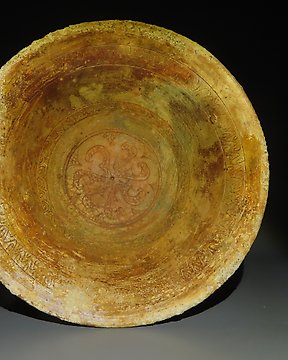
Byzantine Ceramic Bowl with sgraffito decoration. 10th-12th century AD. 20 cm diameter.
No. 81658177

No. 81658177

A Byzantine grey ceramic vessel featuring a hollow globular body with a pointed base. To the top, the vessel rises into a short narrow neck defined by a circular ridge and tapers out into a conical head which finally ends in a small mouth. Four pointed ridges runs vertically from the neck to half length of the body. They were accompanied by columns of braided motifs for decoration, however most of which has faded over time. Such item would have been filled with an explosive liquid known as ‘Greek Fire’ and used as a hand grenade. Chip to the mouth and base of the grenade. Cavities dotted around the body of the grenade and earthly encrustations to the surface.
Greek fire, also referred to as liquid fire, was the most famous weapon in the Byzantine arsenal, saving the Byzantines for centuries from Arab attacks. Being used in both defence and attack situations, the weapon proved significant in the survival of the Byzantine Empire. The formula for the flammable mixture was closely guarded for centuries and irredeemably lost after the collapse of the Empire. Its precise composition thus remains unknown to this day, though research suggests the use of petroleum as a vital ingredient. Their average size and grip suggest the vessel being thrown by hand, in short-range conflicts, but this does not exclude the use of grenades in long-distance battles and at sea; as they were most likely hurled by catapults.
Measurements: L 10 cm x W 7.5 cm
Provenance: Ex private UK collection, acquired 1990s.
How to buy on Catawiki
1. Discover something special
2. Place the top bid
3. Make a secure payment